What Is the 1938 Washington Quarter Made Of?
The Washington Quarter is still in wide circulation and is a great series for individuals who want to start collecting coins as a hobby. The Washington Quarter, sometimes known as a quarter dollar, is the 25-cent coin minted in the United States.
If you look at the 1938 quarter, it has a reeded edge with a weight of 5.67 grams and 24.3 millimeters in diameter. Since the Washington Quarter has 2 types, it also has unique compositions. 90% silver and 10% copper make up the first variety, the silver composition, used from 1932 to 1964.
Following a jump in the price of silver, the second variety—a clad composition of 91.67 percent copper and 8.33 percent nickel—was implemented in 1965 and can be found in all following Washington quarter issues.
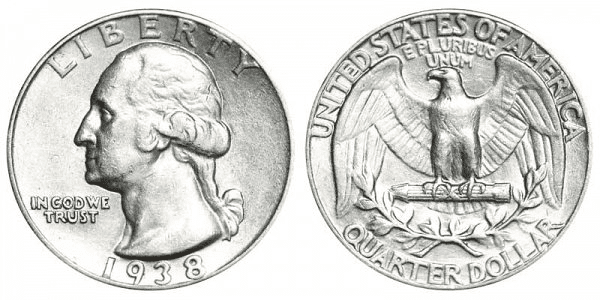
Features a profile bust of Washington on the obverse with the following inscriptions:
- LIBERTY
- IN GOD WE TRUST
- 1938 the year of mintage is listed at the bottom.
The beautiful reverse face features an eagle poised atop an olive branch, with the following inscriptions:
- UNITED STATES OF AMERICA
- E PLURIBUS UNUM
- QUARTER DOLLAR
It has been over 90 years since the first strike of the quarter. Sculptor John Flanagan was responsible for creating the first version. Members of the bicentennial committee sought a George Washington half-dollar as the country prepared to commemorate the bicentennial of the birth of its first president in 1932.
They only sought to replace the standard Walking Liberty a half dollar for that year; however, Congress permanently replaced the Standing Liberty quarter and mandated that a picture of George Washington be on the obverse of the new currency.
The committee requested that Laura Gardin Fraser, a sculptor, modify the design she had created for a memorial medal for the quarter. Despite the Commission of Fine Arts support for Fraser’s work and the endorsement of its chairman, Charles W. Moore, Treasury Secretary Andrew W. Mellon preferred a Flanagan design, and Mellon’s successor, Ogden L. Mills, refused to reverse the choice.
1938 Washington Quarter Varieties
The 1983 Washington Quarters’ genuine scarcity in uncirculated grades may surprise some collectors. Due to a historic recession and the lack of official uncirculated sets created by the US Mint that year, many collectors used their rolls of uncirculated quarters.
1938 Washington Quarter is minted in two locations. With slightly over 12 million quarters produced from Philadelphia and San Francisco combined, 1938 marked a significant decline in overall production. The Denver Mint did not manufacture any quarters in 1938.
In addition, the 1938 Washington quarter prices are slightly higher than those of earlier years due to one of the lowest production runs. San Francisco’s lower production run provides higher value, but only for higher-grade coins.
Below are the varieties of the 1938 Washington Quarter. You can explore and take a look at its details and make a comparison.
1938 P Washington Quarter
Year of minting: 1938
Mint Mark: no mint mark
Place of minting: Philadelphia
Quantity produced: 9,472,000
Face Value: $0.25 (twenty-five cents)
Price: $8 to $80 (circulated condition)
Mass: 6.30 grams
Edge: Reeded
Designer: John Flanagan
Composition: 90% silver and 10% copper
Diameter: 24.30 millimeters
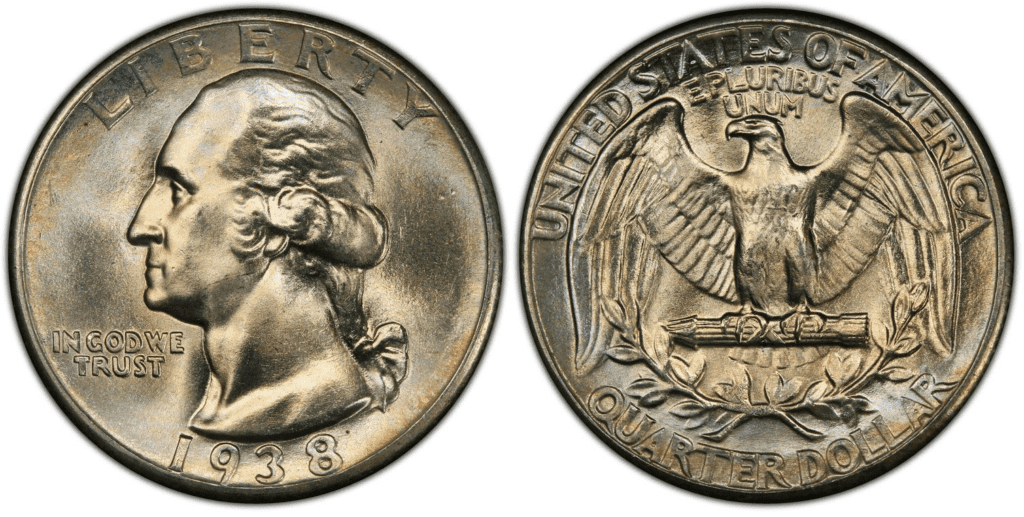
The quantity produced by Philadelphia minting runs over 9 million Washington quarters. Tripling the number of production compared to San Francisco minting.
A 1938 P Washington Quarter Value is worth $3 to $5 at retail if it resembles the G4 coin. Damaged or cleaned coins are worth less in exchange.
1938 S Washington Quarter
Year of minting: 1938
Mint Mark: S
Place of minting: San Francisco
Quantity produced: 2,382,000
Face Value: $0.25 (twenty-five cents)
Price: $8 to $80 (circulated condition)
Mass: 6.30 grams
Edge: Reeded
Designer: John Flanagan
Composition: 90% silver and 10% copper
Diameter: 24.30 millimeters
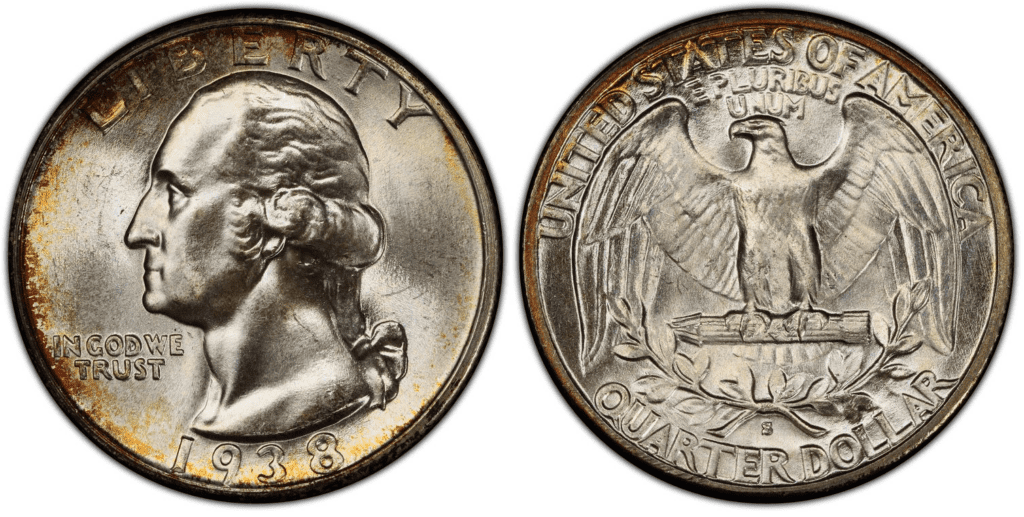
The 1938-S is one of the Washington quarter series’ low mintages and has long been regarded as a desirable semi-key date.
While every S-Mint Washington from the 1930s is regarded as a rarity in the series, it’s easiest to find the 1938-S in Gem uncirculated condition. The strike doesn’t appear to be an issue, and the collector can locate originally toned or frosty white examples to his taste.
1938 Proof Washington Quarter
Year of minting: 1938
Mint Mark: no mint mark
Place of minting: Philadelphia
Quantity produced: 8,045
Face Value: $0.25 (twenty-five cents)
Price: $94 or more (uncirculated condition)
Mass: 6.30 grams
Edge: Reeded
Designer: John Flanagan
Composition: 90% silver and 10% copper
Diameter: 24.30 millimeters
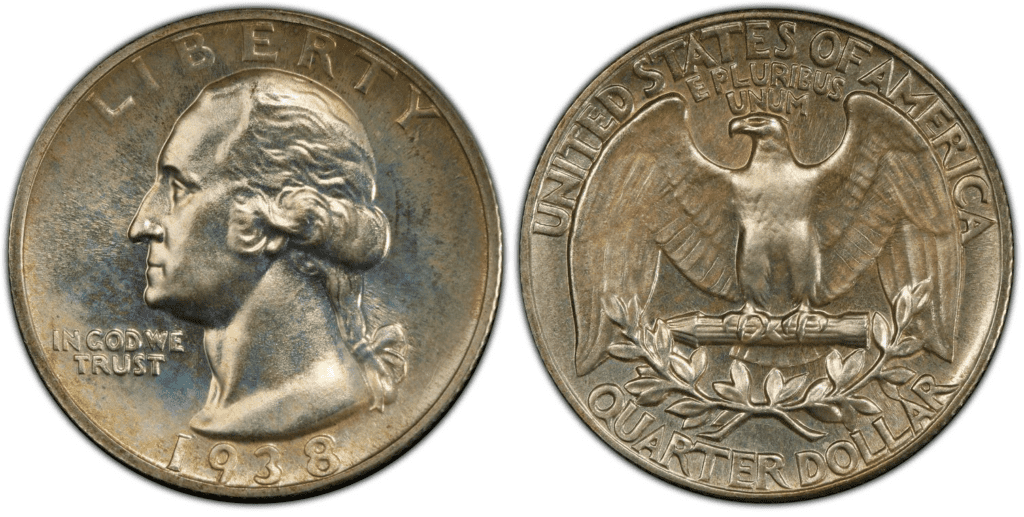
The third-lowest mintage in the Proof Washington Quarter series is for the 1938 Proof Washington Quarters. The majority of remaining specimens appear to be in a PR65 condition. Although examples in PR66 are rare, about 1,000 still exist in this state or higher.
The proof quarters from 1938 show another improvement in quality on average compared to 1936–1937. Although lacking cameo contrast, the majority are pleasantly dazzling.
List Of 1938 Washington Quarter Errors
Coins with mint errors may result from deterioration in the minting machinery, mistakes or faults during production or deliberate actions by mint staff. Accidental mistake coins are likely the most prevalent and, given the rarity of modern minting, are often quite valuable to numismatists.
Searching for error coins is one of the most intriguing activities for coin collectors. The numismatic value of these coins is very high. For coin dealers or collectors, they can hold a lot of interest.
There are a lot of different types of Errors in coins. You’ll need a keen eye and lots of patience to recognize an error coin. It’s important to know what to look for. Noticing an odd-looking coin is an excellent place to start, but it is best to become familiar with common mistakes.
While some coin faults are visible, others are more subtle and can necessitate a magnifying lens. Below are the samples of Washington quarter mint errors:
Clipped Planchet
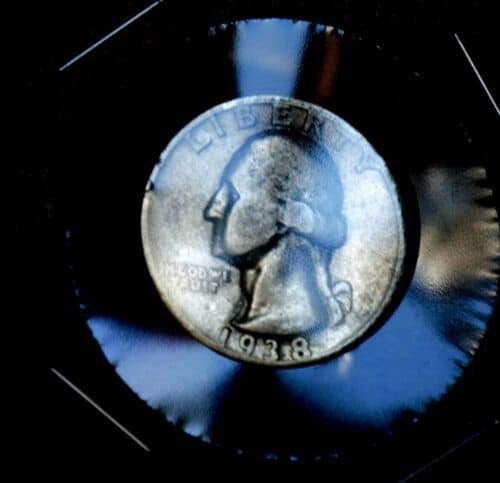
The sample above shows one of the most common coins error, the clipped planchet. This failure happens when the blanking press retracts after partially punching the planchet strip.
On the sample above, the error can be found on the obverse side, above the left of the phrase IN GOD WE TRUST. You can touch the coin’s ridges and look at it to determine whether the planchet has been clipped.
Doubled Die
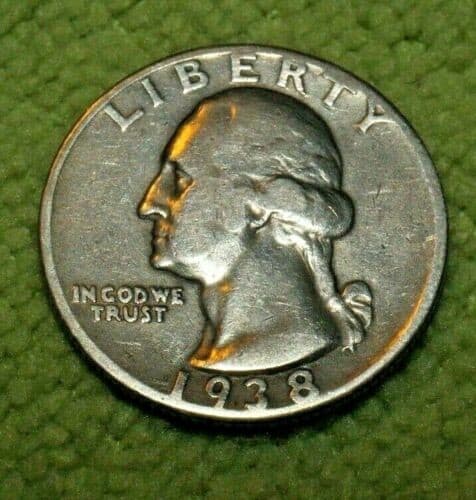
Hub doubling or more known as doubled die. This error occurs in a design duplicate on a functional die due to the hubbing process’s misalignment of the hub or dies. The intensity of the doubling can range from extremely small and localized to intense and pervasive.
The precise reason for doubling can also differ, which is why a classification system was developed to include the recognized and potential reasons.
The second T is strongly double in the sample above the word TRUST. For some people, this can be seen or noticed by the naked eye.
How Much Is The 1938 Washington Quarter Worth Today?
These coins appeal to collectors for reasons other than just the fact that they are made of silver. Additionally, these coins are particularly significant in the eyes of collectors since they are a part of the history of American coinage.
The NGC Price Guide estimates that a 1938 Washington Quarter in the circulated condition is worth between $8 and $90 as of January 2023. However, 1938 S Quarters that are flawless and uncirculated can be purchased for as high as $1625 on the open market.
The value of the 1938 Washington Quarter would be based on many factors. It will consider the coin’s grade, how rare it is, the condition, and where it is minted.
Its melt value will be calculated by how much the coin’s metal content is. The 1938 Washington Quarter is made out of 90% silver and 10% copper with a silver weight of 1808 oz. As of January 2023, the melt value of this coin would range from $4.27. The price would change depending on the price of silver occasionally.
To understand the value of a 1938 quarter, check out this table that compares the auction records for each variety:
| Coin | Condition | Grade | Sold date | Sold by | Value |
| 1938 P Washington Quarter | Superb Gem Uncirculated | MS 68 | October 10, 2021 | Heritage Auctions | $14,400 |
| 1938 Washington Quarter | Superb Gem Uncirculated | PR 68 | September 1, 2005 | Heritage Auctions | $13,800 |
| 1938 Washington Quarter | Superb Gem Uncirculated | MS 67+ | October 29, 2015 | Heritage Auctions | $5,170 |
How Does The Grading System Work?
The grading system of the Washington quarter would be down to the classification of grades.
Professional numismatists joined in the 1970s and established CoinGrading standards, known as the Sheldon Scale. These numismatists now assign grades at key places on the seventy-point scale, using the most regularly utilized numeric points in conjunction with the original adjective grade. The following are the most common coin grades:
- (P-1) Poor – Indistinguishable and probably damaged; if used, must have a date and mintmark; otherwise, rather battered.
- (FR-2) Fair – Nearly smooth, but without the damage that a coin graded Poor often possesses. The coin must have enough detail to be identified.
- (G-4) Fair – Inscriptions have merged into the rims in some areas, and important elements have been mostly erased.
- (VG-8) Very Good- A little weathered, but all primary design elements are visible, albeit faintly. There is little, if any, central detail left.
- (F-12) Good – The item is very worn, yet the wear is even, and the overall design details stand out clearly. Rims are almost completely isolated from the field.
- (VF-20) Very Fine – Moderately weathered, with some finer features still visible. The motto or all letters of LIBERTY are readable. Both sides of the coin have entire rims separated from the field.
- (EF-40) Extremely Fine – Gently used; all gadgets are visible, and the most important ones are bold. The finer details are bold and clear; however, light wear may be seen.
- (AU-50) Uncirculated – Slight evidence of wear on the coin’s design’s high points; it may have contact marks; eye appeal should be adequate.
- (AU-58) Uncirculated Choice – Slight traces of wear, no severe contact marks, almost full mint shine, and great eye appeal.
- (MS-60) Mint State Basal – Strictly uncirculated; no indication of wear on the coin’s highest points, but an unsightly coin with reduced luster, visible contact marks, hairlines, and other flaws.
- (MS-63) Mint State Acceptable – Uncirculated, but with contact scratches and nicks, little reduced shine, but otherwise appealing appearance. The strike is weak to average.
- (MS-65) Mint State Choice – Uncirculated with great mint shine, little contact blemishes, and exceptional eye appeal. The strike is unusually severe.
- (MS-68) Mint State Premium Quality – Uncirculated with superb luster, no obvious contact marks to the naked eye, and exceptional eye appeal. The strike is quick and appealing.
- (MS-69) Almost Perfect Mint State – Uncirculated with perfect brilliance, a sharp and appealing strike, and extremely good eye appeal. A near-perfect coin with minor imperfections in the planchet, strike, and contact markings (seen only under 8x magnification).
- (MS-70) Mint State Perfect – Under 8x magnification, no tiny imperfections are discernible; the strike is crisp, and the coin is perfectly centered on a beautiful planchet. Rarely seen on a coin, this coin is bright and whole, with original luster and exceptional eye appeal.
Where To Buy Or Sell 1938 Washington Quarter?
The best and hassle-free way to buy and sell the 1938 Washington Quarter is on the Internet.
Different platforms have marketplaces where you can scan and post items if you want to sell them. Communicating as a retailer and consumer online would also be possible.
Local coin shops are an obvious way to sell your coins. They’ll be your best option for selling low- to mid-range antique coins.
FAQs
How much is a 1938 quarter worth today?
The NGC Price Guide estimates that a 1938 Washington Quarter in the circulated condition is worth between $8 and $90 as of January 2023. However, 1938 S Quarters that are flawless and uncirculated can be purchased for as high as $1625 on the open market.
Is a 1938 quarter pure silver?
The 1938 quarter is not entirely made of silver. It has 10% copper in it. The 90% silver content of the coin is equivalent to the actual silver weight of 0.1808oz.
